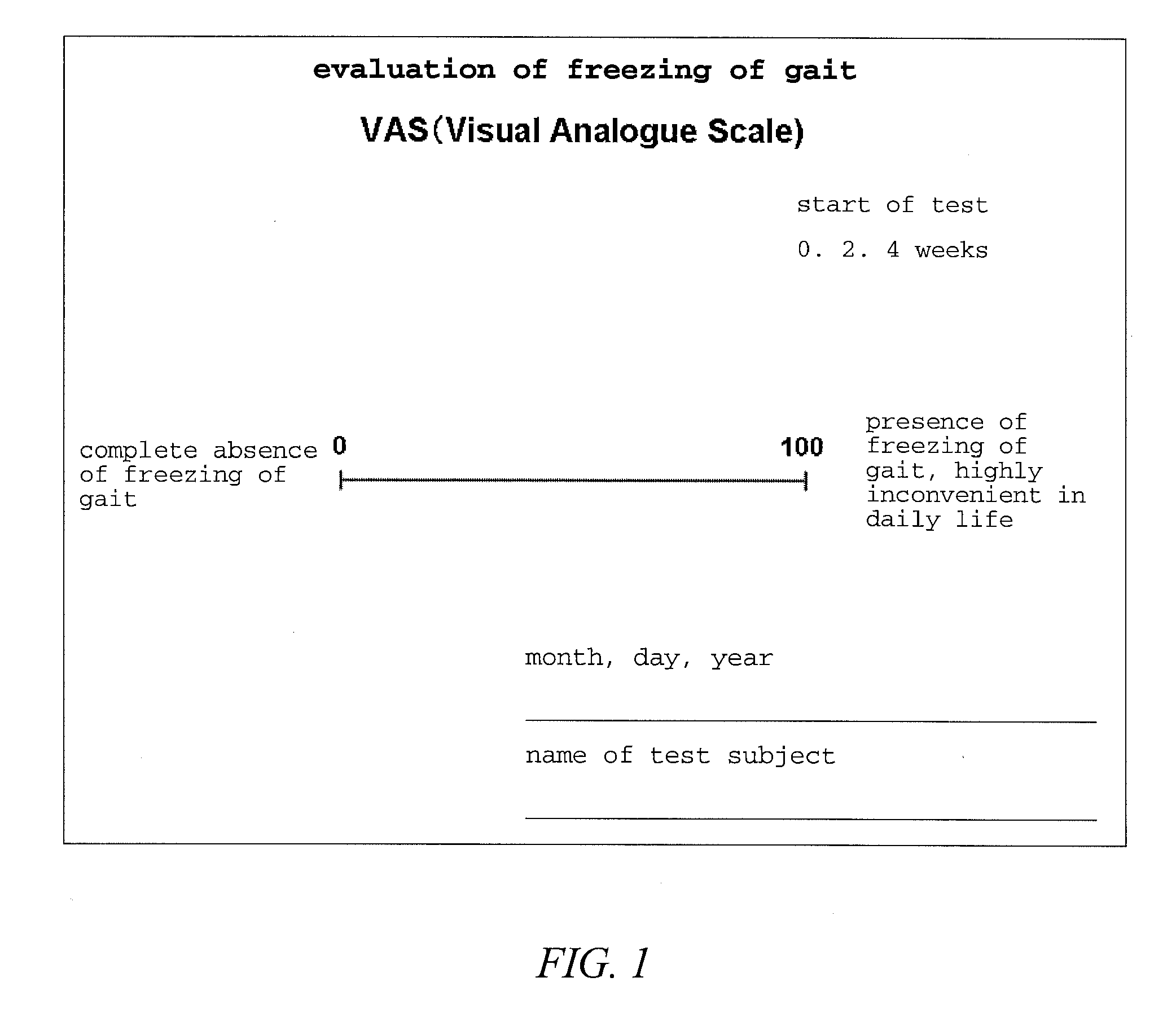Method of treating postural reflex abnormality caused by parkinson's disease
a postural reflex and parkinson's disease technology, applied in the direction of biocide, drug composition, peptide/protein ingredients, etc., can solve the problems that the efficacy rate of dops was not necessarily high, and the l-dopa therapy did not provide a significant effect on axial symptoms, so as to achieve high priority
- Summary
- Abstract
- Description
- Claims
- Application Information
AI Technical Summary
Benefits of technology
Problems solved by technology
Method used
Image
Examples
example 1
[0074]Treatment effect of therapeutic agent of the present invention for PA disease patient with wearing-off phenomenon
(1) Treatment Target Patients
[0075]A PA patient with severity of H&Y grade III (showing wearing-off phenomenon and freezing of gait in ON state): 56-year-old female (disease duration 19 years).
(2) Clinical Tests and Results
[0076]An L-DOPA preparation (Menesit, 400 mg / day) was administered in 7 portions, a dopamine agonist (Permax®, 750 μg / day) was administered in 3 portions, a selective MAO-B inhibitor (FP, 5 mg / day) was administered in 2 portions, and an anticholinergic drug (Artane, 3 mg / day) was administered in 3 portions. However, the wearing-off phenomenon and freezing of gait in the ON state were observed. Falling down occurred once a month.
[0077]When the L-DOPA preparation (Menesit, 700 mg / day) was administered in 7 portions, DOPS (700 mg / day) and a COMT inhibitor (Comtan®, 700 mg / day) were simultaneously administered in 7 portions each. Freezing of gait most...
example 2
[0079]Treatment effect of therapeutic agent of the present invention for PA disease patient with pure akinesia and chief complaint of freezing of gait
(1) Treatment Target Patient
[0080]A PA disease patient with pure akinesia and chief complaint of freezing of gait: 66-year-old female.
(2) Clinical Tests and Results
[0081]a) DOPS (300 mg / day) was administered in 3 portions, but ineffective.
[0082]b) DOPS (300 mg / day) and Comtan® (300 mg / day) as a COMT inhibitor were simultaneously administered in 3 portions each. As a result, a mild improvement was observed.
[0083]c) DOPS (600 mg / day) and Comtan® (300 mg / day) as a COMT inhibitor were simultaneously administered in 3 portions each. As a result, freezing of gait on U-turn disappeared.
(3) Evaluation
[0084]Combined use of DOPS and Comtan® (COMT inhibitor) was effective even in a treatment without using an L-DOPA preparation and a dopamine receptor stimulator.
example 3
[0085]Treatment effect of therapeutic agent of the present invention for PA disease patient with pure akinesia and chief complaint of freezing of gait (patient not responsive to L-DOPA preparation)
(1) Treatment Target Patient
[0086]A PA disease patient with pure akinesia and chief complaint of freezing of gait, not responsive to L-DOPA preparation: 69-year-old male.
(2) Clinical Tests and Results
[0087]a) DOPS (600 mg / day) was administered in 3 portions, and a slight improvement effect was observed.
[0088]b) DOPS (600 mg / day) and Comtan® (300 mg / day) as a COMT inhibitor were administered in combination in 3 portions, and the effect expanded to enable him to go out with a handcart.
(3) Evaluation
[0089]A combined use of DOPS and a COMT inhibitor was effective for the “freezing of gait symptom” for which L-DOPA preparation is not effective.
PUM
| Property | Measurement | Unit |
|---|---|---|
| freezing of gait evaluation | aaaaa | aaaaa |
| DA levels | aaaaa | aaaaa |
| freezing of gait evaluation scale | aaaaa | aaaaa |
Abstract
Description
Claims
Application Information
 Login to View More
Login to View More - R&D
- Intellectual Property
- Life Sciences
- Materials
- Tech Scout
- Unparalleled Data Quality
- Higher Quality Content
- 60% Fewer Hallucinations
Browse by: Latest US Patents, China's latest patents, Technical Efficacy Thesaurus, Application Domain, Technology Topic, Popular Technical Reports.
© 2025 PatSnap. All rights reserved.Legal|Privacy policy|Modern Slavery Act Transparency Statement|Sitemap|About US| Contact US: help@patsnap.com

